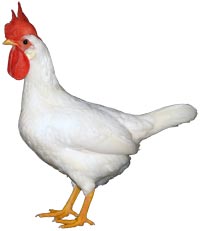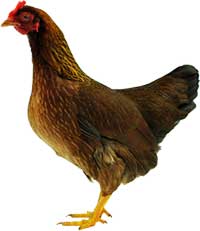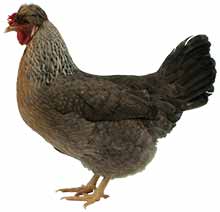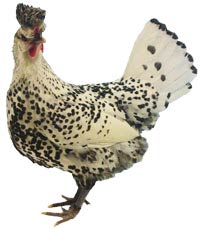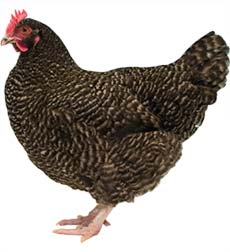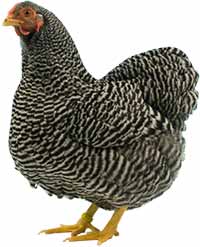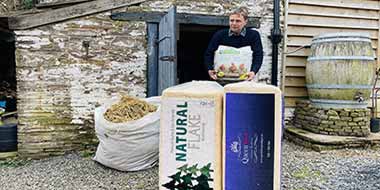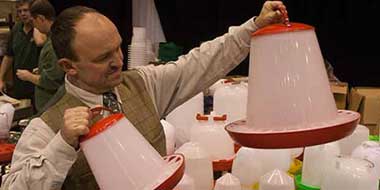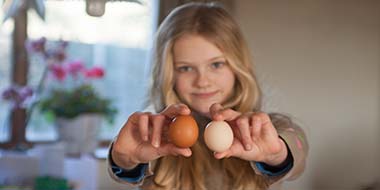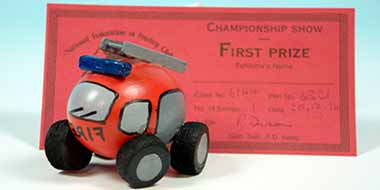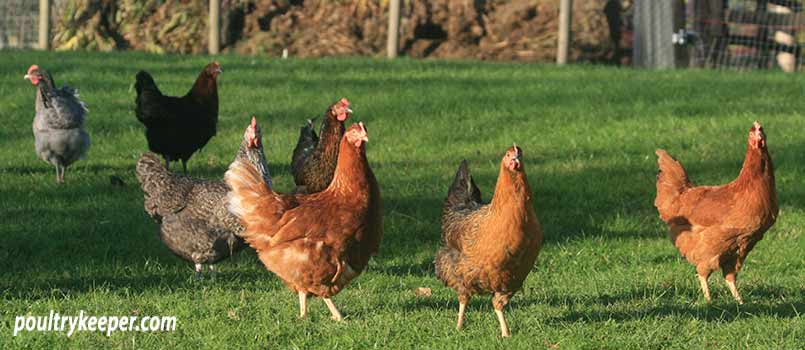
Most of us start keeping chickens for their eggs – and why not? Eggs warm from the nest-box are a modern luxury, guaranteed fresh and of obvious origin.
All chickens lay eggs, but productivity varies widely between the various breeds. If a plentiful supply of eggs is important, then you need to choose your chickens with care.
At one time, the choice would have amongst the traditional pure-breed layers, but now there are several varieties of hybrid hens to consider. Both types have their pros and cons, which may be more or less important depending on your personal circumstances.
Hybrid laying hens
What are they & what are their advantages/disadvantages?
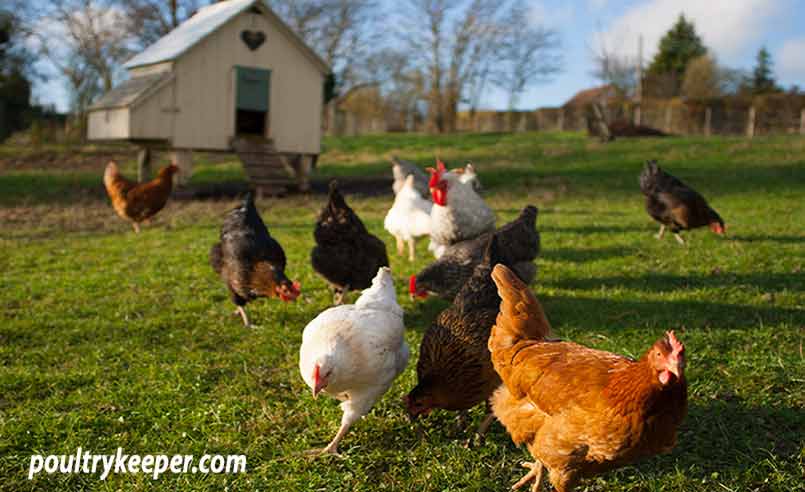
Hybrid hens have been developed through selectively cross-breeding the most productive strains of pure-breed layers. While some characteristics of the original parent stock may remain, hybrid hens are specially bred to be docile, not to go broody and to lay numerous eggs in their first year. The best of them can produce an egg almost every day – at their peak, four hens could give you two dozen eggs a week!
Advantages of hybrids
- High numbers of eggs in the first year of laying
- Egg yields more predictable than with pure-breeds
- Often continue laying through winter
- Mature early – and start laying regardless of time of year
- Usually easy to manage
- Less likely to go broody
- Routinely vaccinated against a number of diseases
- Generally cheaper to buy than pure-breeds
- Several different types and colours to choose from
Disadvantages of hybrids
- Laying can be unpredictable after the first year
- Tend not to live as long as pure-breeds
- Hybrids don’t ‘breed true’ – the only way to obtain more of the same type is to buy new pullets
- Careful feeding is particularly important for hybrids to meet the demands of intensive egg-production
- Hybrid layers are usually too slight to make worthwhile table birds
- Hybrids are less likely to make reliable broodies if you want to hatch some eggs
- Many traditional pure-breeds are declining due to the popularity of hybrids
Different types of hybrid layers
What are the best laying hybrid hens?
Hybrid hens were first created to meet the demands of the egg industry. As egg-laying ‘machines,’ they were designed to be kept in battery cages and lay prolifically for the first year of their lives.
The small brown hens of this type are still used both commercially and as domestic layers. Without question, hybrids must be some of the best laying hens. However, with the increased popularity of chicken-keeping, several other hybrids have been developed to provide a wider choice of hens and egg colours.
Individual suppliers tend to bestow different names on the hybrids they produce, leading to a confusing variety of aliases for effectively the same type of hen.
Some of the most common hybrid layers
Warren, ISA Brown, Goldline, Gold Star, Lohmann, Gingernut Ranger
Originally generated from the Leghorn and Rhode Island Red for the egg industry, there are now many variations on these popular hybrids.
Pullets are readily available, or you could re-home some ex-battery hens via a charity (see our list of hen rehoming charities here).
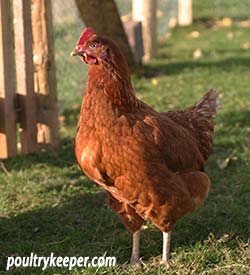
In their first year of laying, hybrids of this type should provide well over 300 light-brown eggs. This declines in the second year when the farms dispose of them, but they can still lay well.
Bred for docility, these are very friendly, trusting birds that will follow their owner around. In a totally free-range setting, this calm disposition could put them at risk.
Amber Star, Silver Link
White with light-brown markings (which can be just a few feathers), this is a pretty hen with a placid temperament.
She comes close to the Warren for productivity.
Eggs may be light brown or cream. She is an active forager.
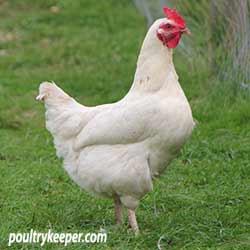
White Star
Based on the White Leghorn, this slightly built white hen is another top layer and produces good-sized white eggs. She is likely to be a bit ‘flightier’ than most hybrids.
Rhode Rock, Bovans Nera, Black Star
Black hens with a ruffle of chestnut neck feathers, these hens are hardy and productive layers of brown eggs. Bred from the Rhode Island Red and Barred Plymouth Rock, they should produce around 270 eggs in their first year.
Black Rock
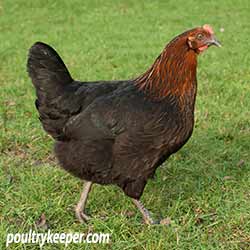
Although similar to the hens above, Black Rocks have been developed over many years from selected strains of the Rhode Island Red and the Barred Plymouth Rock and are only produced by Crosslee Poultry Farm in Scotland. Check the website for registered suppliers as these are the only source of genuine Black Rocks – beware of imitations!
Black Rocks have been specially bred to be hardy and are well-suited to free-ranging, so they have been popular with smallholders. They tend to lay and live longer than other hybrids. In a mixed flock, these large hens may bully more timid breeds.
Columbian Blacktail, Calder Ranger, Black Tail
A chestnut-coloured hen with a black tail and sometimes some black neck feathers too. She lays light brown eggs, is hardy, placid and suitable for free-ranging. Waitrose supermarkets have their own flocks of free-range Columbian Blacktails.
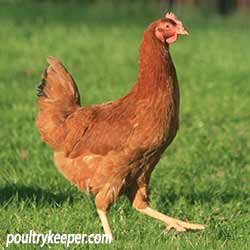
Sussex Star, Sussex Nova
This hybrid is based on the Light Sussex pure-breed and is also white with black markings. She is a good layer of white or light brown eggs.
Bluebelle
One of the larger hybrids, the Bluebelle comes in a pretty grey-blue colouring (although the shades can vary) and is a friendly and docile hen.
She should lay around 260 light brown eggs in her first year.
The Bluebelle trademark is owned by Meadowsweet Poultry.
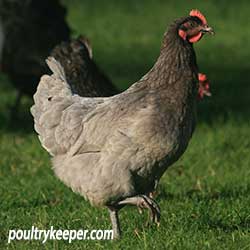
Skyline, Columbine
Again productivity may be less than some other hybrids, but then this hen lays blue or pastel eggs. The hens themselves are grey/blue or cream/brown, and often feature a cute little head tuft.
Speckledy, Speckled Ranger
A dark grey and white mottled hen that is created by crossing a pure bred Rhode Island Red cock with a Marans hen.
The Speckledy has feathering that resembles the Marans and will produce more eggs than this pure breed but may lay slightly less well than some other hybrids. Her eggs are brown and often speckled.
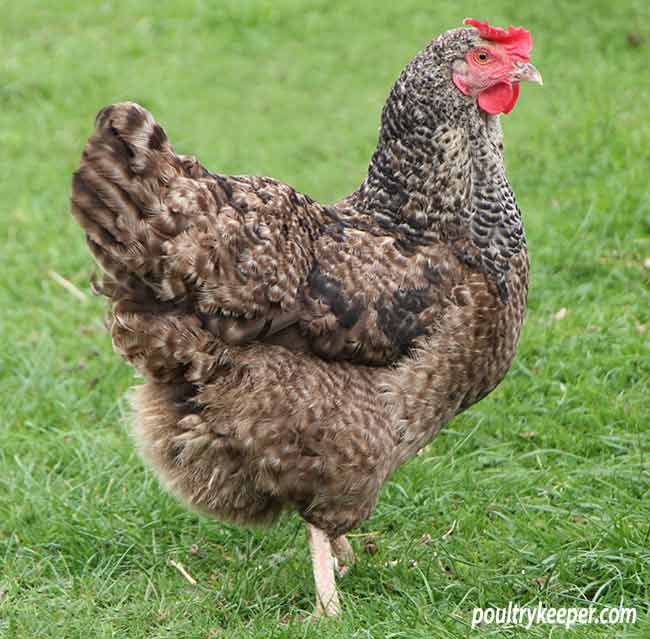
Pure-breed laying hens
What are the best laying hens?
Before hybrids came along, these were the hens for egg production. Although somewhat eclipsed now by the hybrids, a good utility strain of pure-breed should still be capable of giving excellent results.
While many of the pure-breeds are now developed with exhibition rather than eggs in mind, some breeders can supply utility birds designed to lay like their forebears. As with hybrids, the best egg yields are in the first year, but pure-breeds tend to lay for more seasons than hybrids.
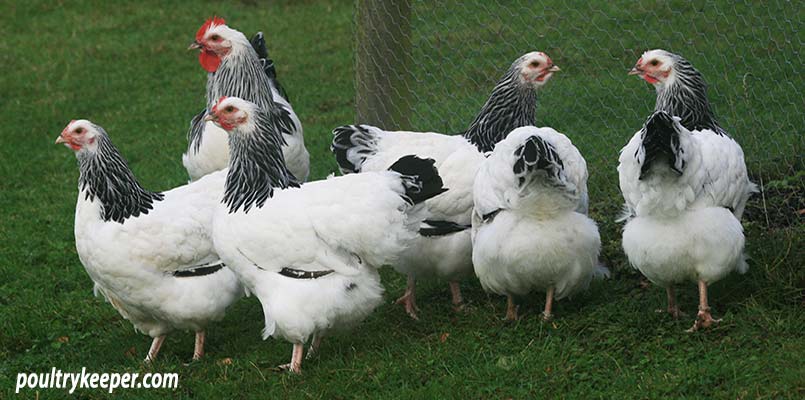
Light Sussex - a dual purpose 'utility' breed that can be a good layer and used for the table.
If you consider the best laying hens over a slightly longer time frame, some utility pure breeds will start to catch up or exceed the hybrid ‘egg machines’ egg-laying capability!
There is a choice between the ‘light’ laying breeds and ‘heavy’ dual-purpose utility chickens, which can be used for both eggs and meat.
Advantages of pure-breed layers
- Are likely to continue laying for more years than hybrids
- Have a better life-expectancy than hybrids
- Less likely to succumb to problems caused by intensive laying
- Are often better suited to free-ranging
- Some are able foragers - given adequate free-range they will find much of their own food
- Breed ‘true’ - offspring resemble the parents
- Cockerels easily available, allowing the breeding of new stock
- Dual-purpose breeds can provide both eggs and meat
- Some breeds make reliable broodies, allowing eggs to be hatched naturally
- Egg colour can be more accurately predicted
- Some breeds make reliable broodies, allowing eggs to be hatched naturally
- Some breeds are becoming rare and need support if they are not to disappear
Disadvantages of pure-breed layers
- May be difficult to predict egg-yields
- Laying often stops or declines sharply in winter
- Some breeds take longer than hybrids to reach point-of-lay
- New pullets often don’t lay their first eggs until spring
- Light breeds can be flighty
- Heavy breeds may go broody
- Might not be vaccinated
- Usually more expensive to purchase than hybrids
Some examples of productive pure-breeds are given below, but there are many others (some now rare or endangered) that could be well worth a look if you see them.
Examples of light laying breeds
Often the Mediterranean in origin, many of these hens were bred to be farmyard foragers. They may fly well and can be a bit skittish, not liking to be handled. However, they are less likely to go broody than some of the more placid chickens.
Note:
For more information and photos, you can click on an image to go to the breed page.
Leghorn
The white Leghorn has been used to develop several hybrids and was originally one of the top hens for egg production. A good utility strain should lay a very respectable quantity of large white eggs – around 300 in the first year.
Leghorns are good foragers but will also adapt to life in a run. Their large combs may need protection from frostbite in extreme temperatures.
Welsummer
The Welsummer is a large and heavy ‘light breed’ that could also be used as a table bird.
This traditional-looking chicken is a productive layer of dark brown eggs that are often speckled. A fairly calm breed, the Welsummer can be kept in a run, but it is also hardy and an able forager. Welsummers can be tricky to find these days, but most lay a very reasonable amount of eggs each year.
Araucana
Also known as the ‘Easter Egg Chicken,’ the Araucana is a good layer of pretty blue eggs -although colour can vary from green to khaki or even pink if the breed strain isn’t pure.
With their bushy facial feathering, these are attractive birds that are hardy and will do well if allowed to free-range, but they can also be kept in a run.
Cream Legbar
Another productive blue egg-layer, the Legbar, has the advantage of being autosexing– which means chicks can be sexed from their down colour at hatch, allowing you to save on rearing costs if you hatch your own.
This active breed is a light medium-sized soft-feather breed, mainly grey with a salmon coloured breast and a small crest.
Less common breeds that could also be worth considering:
As well as being very attractive, the Ancona was once considered an excellent utility bird and is a productive layer of large, white eggs. Hardy and active, this breed is well-suited to free-range.
Appenzeller Spitzhauben
A good layer and very pretty too, this once rare breed is becoming ever more popular and now has its own breed society: www.appenzellerspitzhauben.co.uk.
Much more resilient than they might appear, these energetic birds are ideally suited to free-range and will roost in trees if allowed. Appenzellers are available in several different colour varieties, with the Silver Spangled shown here is the most popular.
Minorca
A large and heavy light breed, the Minorca is a superb layer of good-sized white eggs.
They are excellent foragers and are better given free-range as they can be rather nervous. The large combs may need protection in severe weather.
Examples of dual-purpose chickens
Often more placid than the light breeds, dual-purpose chickens are capable layers and can also be fattened for the table. Traditionally these chickens were kept on small farms to supply eggs and meat. Even those hens that have passed their best laying days can be worth dressing as old-fashioned ‘boiling fowl.’
Some (not all) of these hens are determined broodies. Check when buying, as it can depend somewhat on the individual strain. Although broody hens stop laying, they can be dissuaded from sitting – or used for hatching new chicks.
Rhode Island Red
Well-known as a prolific layer, the Rhode Island Red has been used to develop several hybrids. Eggs are mid-brown, and the birds themselves are a deep red/brown colour.
They mature early and tend to be placid, although cockerels can be aggressive. Look for a utility strain and not one bred for showing. Good layers should provide over 200 eggs in their first year.
Barred Plymouth Rock
This productive breed appreciates being given free range. Barred Plymouth Rocks have created several hybrids due to their excellent laying abilities and docile nature. The ‘barred’ colouring of black and white stripes is particularly eye-catching too.
Light Sussex
This well-known breed is an excellent layer and table bird. The Sussex comes in several colours, but Light Sussex (white with a black tail and neck feathers) is considered the most productive. These birds can be free-ranged or kept in a pen –they are also easy to tame, making them a good choice for beginners.
Marans
The Marans (always with an ‘s’, since its name comes from the town of Marans in southwest France) has been used to create the Speckledy hybrid. They are good layers of glossy, deep brown (sometimes very dark) eggs with, particularly thick shells.
The birds can be kept free-range or in a large run – although they can easily become overweight. They are fairly active foragers when allowed to free-range.
Wyandotte
Although white is the utility strain, this breed also comes in a wide range of attractive colours.
A fairly large chicken, the Wyandotte is an excellent layer but very likely to go broody. They can live free-range or in a run, are placid and generally easy to tame.
This breed would also be a good one for the beginner.
Chicken Breeds Pages
If you are interested in keeping pure breeds, the Chicken Breeds page has photographs of all 93 standardised chicken breeds plus many breed profile pages with more detailed information about a breed.
Getting the most from your hens
Start by choosing healthy hens from a reliable source. Discuss expected egg yields with the breeder before making your decision, especially when buying pure-breeds.
So many factors influence laying that it can be difficult to predict how well any hens will perform. Once new pullets have settled in and begun to lay, you can monitor their progress – unexpectedly low yields may indicate a problem.
And remember that even the best laying hens will perform badly if they aren’t looked after properly!

